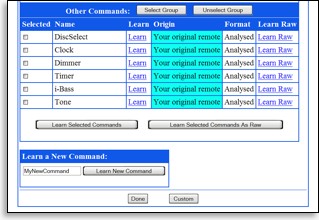|
...Continued from Page 9.
Learned commands fall into two classes, displayed on the command list: “Analyzed” and “Raw”. The former class is for codes where the actual language has been decoded by Intrigue. These signals are represented by compact formulas that can be generated cleanly by the Harmony. “Raw” codes, on the other hand, are long series of numbers that exactly duplicate what the remote saw during the teaching process – in essence, codes that it couldn’t figure out. Generally, normal device codes should always fall in the “analyzed” category, but in rare cases where something is decoded incorrectly, Intrigue also provides an option to force their storage in raw mode. Industry standard Pronto-formatted infrared hex codes can also be imported into a device.
The long road.
Unfortunately, adding new commands not covered by the standard labels in the first two categories can prove a very tedious process. Each command must be named and learned one at a time: every time it’s required to download the learning utility, teach the command, and wait for it to be uploaded back to the website. After that’s complete, the site makes you scroll past the huge list of default commands before reaching the box to enter the next new name. To be fair, about two-thirds to three-quarters of all commonplace functions can be found somewhere within the first two categories, but for any device with a lot of uniquely named functions, this could prove mind numbing!
Looking a bit deeper, it seems like a straightforward problem to correct as it is possible to select multiple customized commands for re-teaching. It’s just that the website forces you to learn each new command as it’s entered, rather than simply adding multiple blank commands to the list and then learning them together.
Activities ahoy!
The list of activities shown on the home page is automatically created from the devices in your home theater. If you have a television, DVD player and audio receiver, the website will automatically add “Watch Television”, “Watch a DVD” and “Listen to Radio” activities. New ones can be added at any time, and activities can always be customized as to which devices they interact with.

Custom learned codes.
|
Three basic activities are assigned to direct-access hard buttons on the remote. These three can be left up to the remote to intelligently determine, or they can be directly specified. Other activities will be displayed two-at-a-time on-screen when the [More Activities] button is pressed. Further pages of activities are shown via the [Next] button.
The SST-659 only includes basic support for macros. Except for the [Off] button, the only other macros are those that activate at the beginning or end of an activity – and they’re automatically generated. Absolutely no macros can be recorded on in-device keys.
The website does permit custom commands to be added to the beginning or end of the default activity macros, however the needed device must first be “included” in the activity. During the advanced setup of an activity, there’s a step where system devices other than the standard three (which are the actual device, plus the video and audio sources) can be incorporated into that activity. Different “types” of inclusion are offered – “Light Controller”, “Sound Processor” and “AV Switch”, along with the more generic “Passthrough” and “Miscellaneous”. Whichever one is selected doesn’t seem to make much of a difference.
| 
